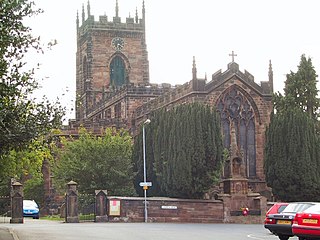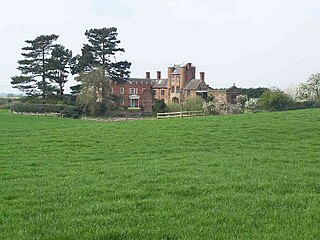
Baron Lyttelton is a title that has been created once in Peerage of England and twice in Peerage of Great Britain, both times for members of the Lyttelton family. Since 1889 the title has been a subsidiary title of the viscountcy of Cobham.

Baron Hatherton, of Hatherton in the County of Stafford, is a title in the Peerage of the United Kingdom. It was created in 1835 for the politician Edward Littleton, Chief Secretary for Ireland from 1833 to 1834. Born Edward Walhouse, he assumed in 1812 by Royal licence the surname of Littleton in lieu of his patronymic on succeeding to the estates of his great-uncle Sir Edward Littleton, 4th and last Baronet, of Teddesley Hall. He was also heir to the substantial Walhouse estates and interests, which included Hatherton Hall, near Cannock, then in an exclave of Wolverhampton. His wealth was based upon landed estates centred on Penkridge in southern Staffordshire, mines at Great Wyrley and Bloxwich, quarries and sandpits, brick yards and residential housing, mainly in Walsall.

Sir Thomas de Littleton or de LyttletonKBSL was an English judge, undersheriff, Lord of Tixall Manor, and legal writer from the Lyttelton family. He was also made a Knight of the Bath by King Edward IV.
Sir Thomas Littleton, 3rd Baronet, often Thomas de Littleton,, of North Ockendon, Essex and Stoke St. Milborough, Shropshire, was an English lawyer and Whig politician who sat in the English and British House of Commons between 1689 and 1709. He served as Speaker of the House of Commons of England from 1698 to 1700, and as Treasurer of the Navy until his death.

Penkridge is a large village and civil parish in South Staffordshire District in Staffordshire, England. It is to the south of Stafford, north of Wolverhampton, west of Cannock, east of Telford and south-east of Newport.

John Lyttelton MP JP (1561–1601) was an English politician and member of the Lyttelton family who served as Member of Parliament for Worcestershire during the reign of Queen Elizabeth I.
Sir Henry Lyttelton, 2nd Baronet was an English politician and member of the Lyttelton family. He was a Royalist officer during the English Civil War. After the Restoration, from 1678 to 1679 he sat in the House of Commons.
Sir Charles Lyttelton, 3rd Baronet, of Frankley, in the County of Worcester, MP was one of the early English Governors of Jamaica, an army officer, and Member of Parliament from the Lyttelton family.
Sir Thomas Lyttelton, 4th Baronet, of Frankley, in the County of Worcester, was an English landowner and Whig politician who sat in the House of Commons from 1721 to 1741. He held office as one of the Lords of the Admiralty from 1727 to 1741.

Sir John Lyttelton was an English nobleman, politician, knight, and landowner from the Lyttelton family during the Tudor period.

Sir Edward Littleton, 1st Baronet was a 17th-century English Baronet and politician from the extended Littleton/Lyttelton family, the first of a line of four Littleton baronets with Pillaton Hall as their seat. He initially joined the Parliamentarians during the English Civil War. Having tried unsuccessfully to find a third way, he switched his support to the Royalist cause – a decision that led to his financial ruin, as large debts made it impossible to redeem his estates from sequestration after the victory of Parliament.
The Vernon family was a wealthy, prolific and widespread English family with 11th-century origins in Vernon, Normandy, France. Their extant titles include Baron Vernon and Vernon baronets of Shotwick Park.

Pillaton Hall was an historic house located in Pillaton, Staffordshire, near Penkridge, England. For more than two centuries it was the seat of the Littleton family, a family of local landowners and politicians. The 15th century gatehouse is the main surviving structure of medieval Pillaton Hall. It is a Scheduled Ancient Monument and a Grade II* listed building. Attached to the Gatehouse to the east is the chapel formerly dedicated to Saint Modwen.
Teddesley Hall was a large Georgian English country house located close to Penkridge in Staffordshire, now demolished. It was the main seat firstly of the Littleton Baronets and then of the Barons Hatherton. The site today retains considerable traces of the hall, gardens and other buildings, while the former home farm remains a working farm.

Penkridge is a village and parish in Staffordshire with a history stretching back to the Anglo-Saxon period. A religious as well as a commercial centre, it was originally centred on the Collegiate Church of St. Michael and All Angels, a chapel royal and royal peculiar that maintained its independence until the Reformation. Mentioned in Domesday, Penkridge underwent a period of growth from the 13th century, as the Forest Law was loosened, and evolved into a patchwork of manors of greatly varying size and importance, heavily dependent on agriculture. From the 16th century it was increasingly dominated by a single landed gentry family, the Littletons, who ultimately attained the Peerage of the United Kingdom as the Barons Hatherton, and who helped modernise its agriculture and education system. The Industrial Revolution inaugurated a steady improvement in transport and communications that helped shape the modern village. In the second half of the 20th century, Penkridge grew rapidly, evolving into a mainly residential area, while retaining its commercial centre, its links with the countryside and its fine church.

Sir Edward Littleton of Pillaton Hall, 4th Baronet, was a long-lived Staffordshire landowner and MP from the extended Littleton/Lyttelton family, who represented Staffordshire in the Parliament of Great Britain and the Parliament of the United Kingdom for a total of 28 years. The last of the Littleton Baronets of Pillaton Hall, he transferred the family seat from eponymous Pillaton to Teddesley Hall, and died childless, leaving the estates to his great-nephew, Edward Walhouse, who became Edward Littleton, 1st Baron Hatherton.

Edward Littleton or Edwarde Lyttelton was a Staffordshire landowner from the extended Littleton/Lyttelton family. He also served as soldier and Member of Parliament for Staffordshire in the House of Commons of England, the lower house of the Parliament of England, five times.

Sir Edward Littleton was a politician from the extended Littleton/Lyttelton family and an important Staffordshire landowner of the Jacobean era and the early Caroline era. Although loyal to the monarchy, he seems to have been of Puritan sympathies and was a close ally of Robert Devereux, 3rd Earl of Essex. He represented Staffordshire in the English parliament of 1624.

The Lyttelton family is a British aristocratic family. Over time, several members of the Lyttelton family were made knights, baronets and peers. Hereditary titles held by the Lyttelton family include the viscountcies of Cobham and Chandos, as well as the Lyttelton barony and Lyttelton baronetcy. Several other members of the family have also risen to prominence, particularly in the field of cricket.

Meriel Lyttelton or Littelton was an English aristocrat with extensive family and court connections. She was a daughter of Sir Thomas Bromley and Elizabeth Fortescue. The MP for Worcestershire Thomas Bromley was her nephew.





















